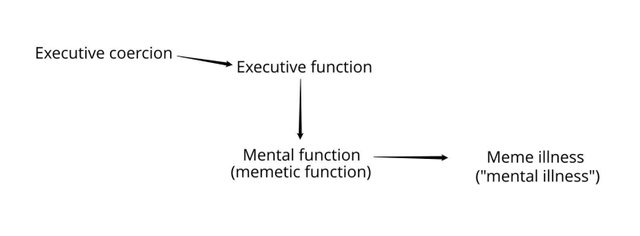Psychiatry is _not medical science_, it is a _human sacrifice ritual_
Obviously, a spontaneous chemical imbalance doesn't cause executive disorders or the culmination of "social defeat" response. Those are all caused by executive coercion. The decreased glutamergic cortical executive functions (that cause increase in mesolimbic dopamine system, as popularized by Stephen M. Stahl) are caused by executive coercion, coercive government. The superstitious belief that executive disorders are caused from within, that cortical executive functions disturb themselves, is spontaneous generation theory, generatio spontanea.
Synapses
Stahl, S. (2007). Beyond the Dopamine Hypothesis to the NMDA Glutamate Receptor Hypofunction Hypothesis of Schizophrenia. CNS Spectrums, 12(4), 265-268. doi:10.1017/S1092852900021015
Stahl, S. M. (2008). Stahl's essential psychopharmacology: Neuroscientific basis and practical applications. Cambridge: Cambridge University Press.
Tidey, J. W., & Miczek, K. A. (1996). Social defeat stress selectively alters mesocorticolimbic dopamine release: an in vivo microdialysis study. Brain research, 721(1-2), 140–149. https://doi.org/10.1016/0006-8993(96)00159-x
Selten, J.-P., & Cantor-Graae, E. (2005). Social defeat: Risk factor for schizophrenia? British Journal of Psychiatry, 187(2), 101–102. https://doi.org/10.1192/bjp.187.2.101
Selten, J. P., van der Ven, E., Rutten, B. P., & Cantor-Graae, E. (2013). The social defeat hypothesis of schizophrenia: an update. Schizophrenia bulletin, 39(6), 1180–1186. https://doi.org/10.1093/schbul/sbt134
Selten, J. P., van Os, J., & Cantor-Graae, E. (2016). The social defeat hypothesis of schizophrenia: issues of measurement and reverse causality. World psychiatry : official journal of the World Psychiatric Association (WPA), 15(3), 294–295. https://doi.org/10.1002/wps.20369
Schalbroeck, R. (2020). The social defeat hypothesis of schizophrenia: A parsimonious explanation for multiple psychosis risk factors? Psychological Medicine, 1-2. doi:10.1017/S0033291720004092
Berton, O. (2006). Essential Role of BDNF in the Mesolimbic Dopamine Pathway in Social Defeat Stress. Science, 311(5762), 864–868. https://doi.org/10.1126/science.1120972
Leigh, H., & Leigh, H. (2010). Genes, Memes, Culture, and Mental Illness. Springer NewYork. https://doi.org/10.1007/978-1-4419-5671-2
Price, J. (1967). THE DOMINANCE HIERARCHY AND THE EVOLUTION OF MENTAL ILLNESS. The Lancet, 290(7509), 243–246. https://doi.org/10.1016/s0140-6736(67)92306-9
Whitley, R. (2008). Is psychiatry a religion? Journal of the Royal Society of Medicine, 101(12), 579–582. https://doi.org/10.1258/jrsm.2008.080044
Moncrieff, J. (2010). Psychiatric diagnosis as a political device. Social Theory & Health, 8(4), 370–382. https://doi.org/10.1057/sth.2009.11
Watts, J., Sheehan, O., Atkinson, Q. D., Bulbulia, J., & Gray, R. D. (2016). Ritual human sacrifice promoted and sustained the evolution of stratified societies. Nature, 532(7598), 228–231. https://doi.org/10.1038/nature17159
Nygren, Johan. (2019). Psychiatry Diagnoses Coercion in Government, Towards a Unified Theory of Psychiatric Disorders. http://doi.org/10.5281/zenodo.3369736
Pribram, K. H. (1973). The primate frontal cortex: Executive of the brain. In K. H. Pribram & A. R. Luria, Psychophysiology of the frontal lobes. Oxford, England: Academic Press.
Karamanou, M., Panayiotakopoulos, G., Tsoucalas, G., Kousoulis, A. A., & Androutsos, G. (2012). From miasmas to germs: a historical approach to theories of infectious disease transmission. Le infezioni in medicina, 20(1), 58–62.
